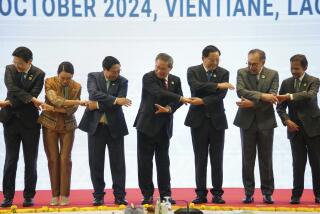S.E. Asia Economy Grew on Borrowed Strength
- Share via
TOKYO — The recent fall of currency and stock markets in Southeast Asia--highlighted by the major financial turmoil last week--has taken many experts by surprise and has been an especially nasty shock to those who thought that nothing major could go wrong economically in that part of the world. However, a closer look reveals that several external factors that contributed to the region’s enormous economic success in the past are no longer in place.
One of those factors is the relationship between the U.S. dollar and the Japanese yen. Although Southeast Asian currencies have depreciated sharply against the dollar recently, most of the depreciation is really a response to the weakness of the yen. Indeed, the yen has plunged in value against the U.S. dollar in the last two years--a development that has had tremendous impact on Southeast Asian economies.
*
Those economies were the primary beneficiaries of the strong yen between 1985 and 1995. The strong yen prompted Japanese companies to increase both their imports from the rest of Asia and their direct investment in the region. Those two factors boosted Southeast Asian economies in a major way. Indeed, a large proportion of the phenomenal growth observed in these economies during that time resulted from the activities of Japanese companies.
During the last two years, however, the yen has been one of the weakest currencies in the world, falling at one point to as much as 60% below its peak against the dollar. Since Southeast Asian currencies were largely pegged to the dollar, this meant a similar appreciation of these currencies against the yen. That appreciation, in turn, made these economies unattractive to the Japanese as a manufacturing base and source of imports. As a result, the inflow of Japanese capital slowed while the trade deficits of those countries soared.
Put another way, the economies in Southeast Asia had an artificial boost from 1985 to 1995, but now the currencies have since returned to levels that reflect the true fundamentals of their respective economies. In that sense, what has happened is actually healthy and in line with the fundamentals.
Another economic elephant--namely China--is also affecting the mix in a major way. Ten years ago, when Japanese companies were looking for low-cost places to relocate their factories, China was nowhere in sight. As a result, most Japanese direct investment flows headed to Southeast Asia. Today, China is very much in the competition, with lower wages and a huge domestic market. For Japan and Taiwan, the two capital exporters in the region, China is much closer culturally as well.
Since foreign capital goes only to the most attractive destination, the fact that China is in the race means that Southeast Asian countries must work much harder to attract overseas funds. For example, they may have to deregulate and open their markets more than they did before. They may also want to build better legal infrastructures for foreign investors, since this is one area in which the Chinese have a long way to go.
The point is that Southeast Asian countries are now caught among three economic giants. Steering clear of them and still carving out something for themselves is no easy task.
*
Another problem is that because the 1985-95 period was so good, both locals and foreigners were totally unprepared for the changes. When the crisis hit, most political leaders and investors were caught by surprise, and there is still no sense of crisis among the political leaders. Indeed, they have made the situation worse by blaming their troubles on foreign investors--the very people who provided the engine of growth in 1985-95. These leaders’ lack of understanding of the economic realities has increased the shock of the foreign investment community and deepened the crisis even further.
For governments in Southeast Asia to regain credibility with the global investment community, they will first have to admit that what they thought was their own strength was really one borrowed from the Japanese. Second, in view of the Chinese competition, they will have to embark on programs to make their economies more attractive to foreign investors.
Until such initiatives have been taken, it will be difficult to imagine the countries of Southeast Asia returning to a rapid growth path any time soon.
More to Read
Inside the business of entertainment
The Wide Shot brings you news, analysis and insights on everything from streaming wars to production — and what it all means for the future.
You may occasionally receive promotional content from the Los Angeles Times.








